Abstract
초록
Figures and Tables
 | Fig. 1Normal configuration of the vesicoureteral junction and antireflux action of the vesicoureteral reflux.
A. Slanted entering and submucosal tunneling of the ureter of sufficient length is the normal configuration of the vesicoureteral junction. The yellow dotted line represents a downstream flow of the urine.
B. The normal ureterovesical junction is closed during contracture on voiding by constriction and compression of the intramural ureter to protect the upper urinary tract from reflux, which is called the antireflux action of the vesicoureteral junction. The yellow dotted line represents a blocked urine flow without reflux.
|
 | Fig. 3Supplies for voiding cystourethrography.
A. From the left upper corner in a counterclockwise direction: 1) iodine-containing contrast (300 or 350 mg/mL); 2) syringe for contrast mixing; 3) saline bag; 4) sterile lubricant gel; 5) chlorhexidine balls; 6) 5- and 8-French catheters; 7) sterile surgical gloves; 8) plastic extension tubing; 9) syringe for regurgitation of urine; and (10) sterile surgical drape with a hole.
B. Warmer for maintaining the body temperature in young infants and light for better visibility during catheter insertion.
|
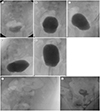 | Fig. 4Standardized evaluation of voiding cystourethrography in critical areas and conditions.
A. AP projection of the urinary bladder in the early filling phase.
B. AP projection of the urinary bladder in the late filling phase.
C, D. Oblique projection of the urinary bladder focusing on the vesicoureteral junction.
E. AP projection of the urinary bladder during voiding.
F. Renal collecting system with and without the presence of reflux.
G. AP projection of the urinary bladder after voiding.
AP = anteroposterior
|
 | Fig. 5Anteroposterior image of the urinary bladder demonstrating ureteroceles (arrow) in the early filling phase. |
 | Fig. 6Value of the oblique projection of the urinary bladder focusing on the vesicoureteral junction.
A. The vesicoureteral reflux is well-demonstrated on oblique projection.
B. The presence of ureteroceles with eversion (arrow) is well-demonstrated on oblique projection.
C. The intravesical simple ureterocele (arrow) is well-demonstrated on oblique projection. The filling defect at the bladder apex (asterisk) is ballooning of the Foley catheter.
|
 | Fig. 7Value of cyclic VCUG.
A, B. Grade I (arrow, B) of the left VUR is demonstrated in the first session of VCUG. VUR is absent in the right urinary system.
C, D. In the second session of VCUG, the left VUR grade changes from I to II (black arrows, D). The newly developed grade II of the right VUR (white arrow) is demonstrated. Finally, bilateral grade II VUR (white and black arrows) is demonstrated in the second session of VCUG.
VCUG = voiding cystourethrography, VUR = vesicoureteral reflux
|
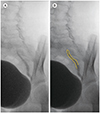 | Fig. 8Vesicoureteral reflux grade I.
A. Vesicoureteral reflux grade I: ureter.
B. The border of refluxed contrast is marked with yellow line.
|
 | Fig. 9Vesicoureteral reflux grade II.
A, B. Vesicoureteral reflux grade II: ureter, pelvis, and calyces; no dilatation; normal calyceal fornices.
|
 | Fig. 10Vesicoureteral reflux grade III.
A, B. Vesicoureteral reflux grade III: mild to moderate dilatation and/or tortuosity of the ureter and mild to moderate dilatation of the renal pelvis; no or slight blunting of the fornices.
|
 | Fig. 11Vesicoureteral reflux grade IV.
A, B. Vesicoureteral reflux grade IV: moderate dilatation and/or tortuosity of the ureter and moderate dilatation of the renal pelvis and calyces; complete obliteration of the sharp angle of the fornices but maintenance of the papillary impressions (arrow, B) in most calyces.
|
 | Fig. 12Vesicoureteral reflux grade V.
A, B. Gross dilatation and tortuosity of the ureter and gross dilatation of the renal pelvis and calyces; papillary impressions are no longer visible in most calyces.
|
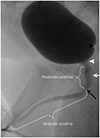 | Fig. 13Lateral anatomy of the urinary bladder and urethra. The interureteric ridge (black arrowhead) is the elevated border of the trigone toward the head. It is visible on lateral projection in approximately the distal one-quarter of the posteroinferior urinary bladder. The cone-shaped portion is the bladder neck (white arrowhead), which is continuous with the bladder apex. The elongated, faint filling defect below the bladder neck is the verumontanum (white arrow), which is the rounded eminence of the urethral crest in the posterior wall of the mid prostatic urethra. The shortest (about 1 cm long) and narrowest portion of the urethra is the membranous urethra (black arrow). The urethra is divided into the anterior and posterior urethra at the lower end of the membranous urethra; distal to the lower end of the membranous urethra is the anterior urethra, while proximal to the lower end of the membranous urethra is the posterior urethra. |
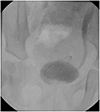 | Fig. 14Low-pressure vesicoureteral reflux. The vesicoureteral reflux occurred in the early phase of bladder filling. Vesicoureteral reflux with low-pressure and early filling is associated with poor resolution and increased risk for acute pyelonephritis. |
 | Fig. 15Contrast reflux in the vagina.
A, B. Contrast reflux in the vagina (arrows), which is common in girls during voiding, is noted on anteroposterior (A) and lateral (B) projections.
|
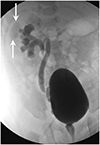 | Fig. 16Intra-renal reflux. The intra-renal reflux refers to the reflux of contrast in the renal papilla via the ducts of Bellini (arrows). It is not included in the international criteria for grading of vesicoureteral reflux; however, it should be described, as it is an important factor for renal scarring in ascending infection. |
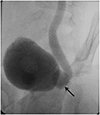 | Fig. 17Paraureteral (Hutch) diverticulum. Diverticulum at the ureterovesical junction is called the paraureteral or Hutch diverticulum (arrow). The vesicoureteral reflux is associated with the Hutch diverticulum. The vesicoureteral reflux from the Hutch diverticulum does not resolve without surgical correction and leaves causes renal scarring. |
 | Fig. 18Physiology and time course of the vesicoureteral reflux associated with the paraureteral diverticulum (asterisks).
A. When the ureter opens on the rim of the diverticulum, and the bladder is completely distended, the ureteral orifice is incorporated transiently in the bladder diverticulum.
B. When the ureter enters the diverticulum directly, the ureteral orifice is incorporated permanently in the bladder diverticulum.
C. In both A and B, the antireflux ureterovesical mechanism is rendered incompetent and leads to secondary vesicoureteral reflux and endstage renal disease.
|
 | Fig. 19Erroneous performance.
A. Obtaining images without collimation.
B. Obtaining excessive number of images (arrow) and taking excessive fluoroscopic time (arrowhead).
|
 | Fig. 20Contrast diluted with the remaining urine.
A. Although the contrast mixture was strictly made using the standard recipe, insufficient opacification of the contrast may be associated with dilution with the remaining urine in the bladder.
B. Emptying the bladder through natural drainage or regurgitation with a syringe after the anchoring catheter renders sufficient opacification.
|
 | Fig. 21Value of the orthographic projection and application on calyceal evaluation.
A. In the orthographic projection, objects are represented on parallel projection to the principal axes. An accurate evaluation of the actual contour of objection is demonstrated by the orthogonal plane.
B. The orthogonal plane for calyceal evaluation is tangential to the renal hilar axis, which is directed anteromedially. It is recommended to prepare the patient's body for the tangential projection of the expected renal hilum.
C. The actual contour of the object can be altered using the oblique projection.
D. Calyceal blunting can be distorted in the anteroposterior projection to the body which is oblique projection to calyces.
|




 PDF
PDF ePub
ePub Citation
Citation Print
Print






 XML Download
XML Download